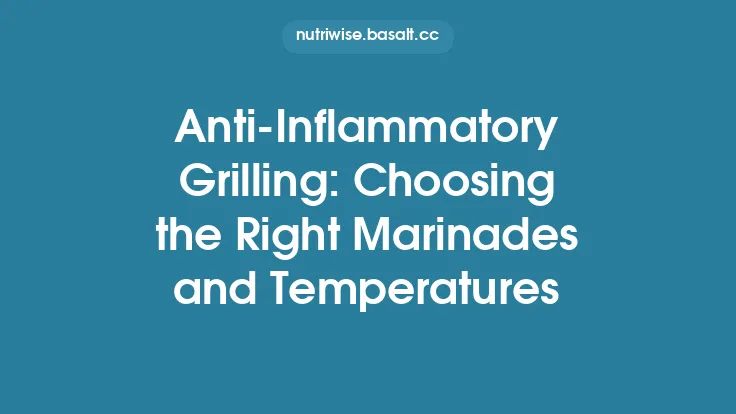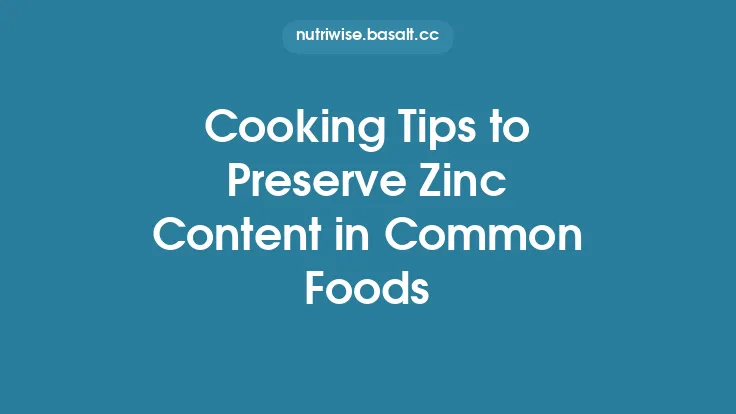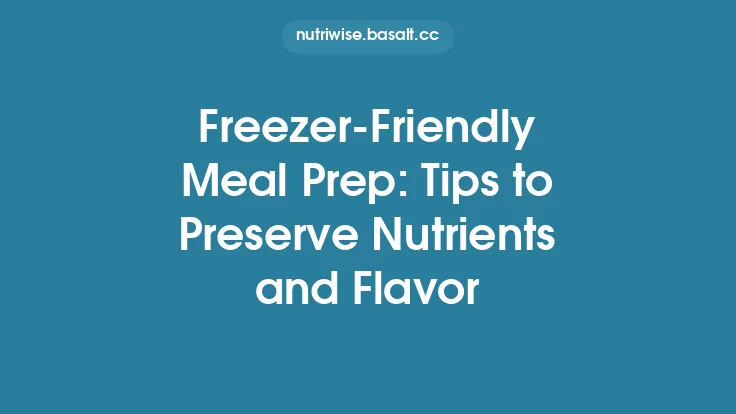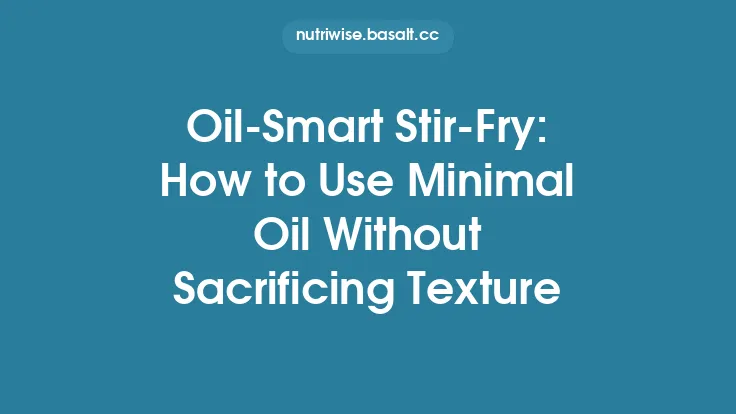Low‑heat searing is often overlooked in favor of the dramatic, high‑temperature “sizzle” that most home cooks associate with a perfect steak or a caramelized crust. Yet, when the goal is to retain the delicate anti‑inflammatory compounds found in many foods—such as polyphenols, flavonoids, omega‑3 fatty acids, and certain vitamins—a gentler approach can make a substantial difference. By mastering low‑heat searing, you can achieve a pleasing surface texture while safeguarding the very nutrients that help combat chronic inflammation.
Understanding Anti‑Inflammatory Nutrients
Anti‑inflammatory nutrients are a diverse group of bioactive compounds that modulate the body’s inflammatory pathways. The most common include:
| Nutrient | Primary Food Sources | Anti‑Inflammatory Mechanism |
|---|---|---|
| Omega‑3 fatty acids (EPA, DHA) | Fatty fish (salmon, mackerel), chia seeds, walnuts | Compete with arachidonic acid, reducing pro‑inflammatory eicosanoids |
| Polyphenols (e.g., curcumin, quercetin, resveratrol) | Turmeric, onions, berries, grapes, dark chocolate | Scavenge free radicals, inhibit NF‑κB signaling |
| Flavonoids (e.g., catechins, anthocyanins) | Green tea, blueberries, red cabbage | Modulate cytokine production, protect endothelial cells |
| Vitamin C & E | Citrus fruits, bell peppers, nuts, seeds | Antioxidant protection of cell membranes |
| Beta‑carotene & lutein | Carrots, sweet potatoes, leafy greens | Neutralize oxidative stress in tissues |
These compounds are often heat‑sensitive. Excessive temperatures can degrade them, alter their molecular structure, or cause oxidation that diminishes their bioactivity. Low‑heat searing, when executed correctly, minimizes these losses while still delivering the Maillard‑driven flavor development that makes seared foods so appealing.
The Science Behind Low‑Heat Searing
1. Maillard Reaction at Lower Temperatures
The Maillard reaction—responsible for the golden‑brown crust and complex flavor notes—begins around 120 °C (248 °F) and accelerates as temperature rises. While high heat (≥180 °C/356 °F) produces rapid browning, it also creates a harsher environment for delicate nutrients. At 140–160 °C (284–320 °F), the reaction proceeds more slowly, allowing a controlled development of flavor without excessive thermal stress.
2. Lipid Oxidation Control
When cooking fats reach their smoke point, free radicals form, leading to lipid oxidation. Oxidized lipids can be pro‑inflammatory. By keeping the pan temperature below the smoke point of the chosen oil (e.g., extra‑virgin olive oil ~190 °C/374 °F, avocado oil ~270 °C/518 °F), you limit the generation of these harmful compounds.
3. Enzyme Preservation
Certain anti‑inflammatory enzymes, such as glutathione peroxidase in vegetables, retain activity up to 70 °C (158 °F). Low‑heat searing that briefly contacts the surface at 140–160 °C for a few minutes does not raise the internal temperature of the food beyond the enzyme’s denaturation point, preserving their protective effects.
Choosing the Right Pan and Fat
| Pan Material | Heat Conductivity | Ideal Use for Low‑Heat Searing |
|---|---|---|
| Stainless steel (heavy‑bottomed) | Moderate, even | Excellent for precise temperature control; requires pre‑heating and a thin oil film |
| Cast iron | High, retains heat | Good for maintaining a steady low temperature once pre‑heated; avoid overheating |
| Carbon steel | High, quick response | Allows rapid adjustments; ideal for chefs comfortable with temperature tweaks |
| Non‑stick (ceramic‑coated) | Low to moderate | Useful for delicate proteins (e.g., fish) where sticking is a concern, but may limit browning depth |
Fat Selection: Choose oils with a high oxidative stability and a smoke point comfortably above your target searing temperature. Preferred options include:
- Refined avocado oil (smoke point ~270 °C) – neutral flavor, high stability.
- High‑oleic sunflower oil (smoke point ~225 °C) – rich in monounsaturated fats.
- Ghee (clarified butter, smoke point ~250 °C) – adds buttery notes without the milk solids that burn quickly.
Avoid extra‑virgin olive oil for prolonged searing above 190 °C, as it can produce off‑flavors and oxidative by‑products.
Temperature Management Techniques
- Infrared Thermometer or Surface Probe – Provides instant feedback on pan surface temperature. Aim for 140–160 °C before adding food.
- Butterfly Thermometer (dual‑probe) – One probe monitors pan surface, the other tracks food’s internal temperature, ensuring the interior stays below 70 °C for enzyme preservation.
- Pre‑heat with a Drop of Water Test – A single droplet should sizzle gently and evaporate within 2–3 seconds at the target temperature.
- Heat‑Resistant Silicone Mats – Placing a thin silicone mat under the pan can dampen temperature spikes, especially on induction cooktops.
- Stovetop Power Modulation – Use low to medium‑low settings; on gas, adjust the flame to a thin, even ring rather than a high blaze.
Ingredient Preparation for Maximum Nutrient Retention
- Pat Dry: Moisture creates steam, which can raise the pan temperature unpredictably and cause uneven browning. Use paper towels to blot proteins and vegetables.
- Uniform Thickness: Slice or pound proteins to an even 1‑2 cm thickness. This ensures the surface sears without the interior overheating, preserving internal nutrients.
- Pre‑Season Lightly: Salt draws out moisture; apply it just before searing to avoid a watery surface. For herbs and spices with heat‑sensitive antioxidants (e.g., basil, cilantro), add them after the sear.
- Coating with Anti‑Inflammatory Powders: Light dustings of turmeric, ground ginger, or cinnamon can create a protective barrier that reduces oxidation while adding anti‑inflammatory phytochemicals.
Step‑by‑Step Low‑Heat Searing Process
- Pre‑heat the Pan
- Set the burner to low‑medium.
- Place the pan on the heat source and allow it to warm for 2–3 minutes.
- Verify surface temperature with an infrared thermometer (140–160 °C).
- Add Fat
- Pour 1–2 tbsp of refined avocado oil or ghee.
- Swirl to coat evenly; the oil should shimmer but not smoke.
- Introduce the Food
- Gently lay the prepared protein or vegetable in a single layer.
- Avoid crowding; overcrowding drops the pan temperature and leads to steaming.
- Sear Without Moving
- Let the food sit undisturbed for 2–3 minutes.
- Observe the edges; a light golden hue indicates the Maillard reaction is progressing.
- Flip and Finish
- Using a thin metal spatula, flip the piece.
- Sear the opposite side for another 2–3 minutes.
- For thicker cuts, reduce heat slightly and add a splash of broth or water, covering the pan for 1–2 minutes to finish cooking through without exceeding 70 °C internally.
- Rest
- Transfer the seared item to a warm plate.
- Allow a 2‑minute rest; this redistributes juices and lets residual heat complete the cooking without further nutrient loss.
- Finish with Anti‑Inflammatory Boosters
- Drizzle a teaspoon of cold‑pressed extra‑virgin olive oil (rich in polyphenols) or a squeeze of fresh lemon (vitamin C) just before serving.
Common Pitfalls and How to Avoid Them
| Pitfall | Consequence | Solution |
|---|---|---|
| Overheating the pan | Oxidation of fats, loss of polyphenols | Use a thermometer; keep a close eye on the oil’s shimmer. |
| Excess moisture on food | Steam formation, uneven browning | Pat dry thoroughly; consider a brief air‑dry on a rack. |
| Crowding the pan | Temperature drop, soggy texture | Cook in batches; keep the pan uncovered between batches. |
| Using low‑smoke‑point oils | Smoke, bitter flavors, pro‑inflammatory compounds | Choose high‑smoke‑point fats; reserve delicate oils for finishing. |
| Prolonged cooking time | Nutrient degradation, tough texture | Stick to the 2‑3 minute per side guideline; monitor internal temperature. |
Pairing Low‑Heat Searing with Complementary Techniques
While this article focuses exclusively on low‑heat searing, you can amplify anti‑inflammatory benefits by integrating other non‑overlapping methods:
- Finish with a quick flash‑blanch of leafy greens (1‑2 seconds in boiling water) to lock in lutein and vitamin C before serving alongside the seared protein.
- Add a cold‑pressed dressing rich in omega‑3s (e.g., walnut‑oil vinaigrette) after plating to boost the overall anti‑inflammatory profile.
- Serve with fermented sides (kimchi, sauerkraut) that provide probiotic support, complementing the reduced inflammation from the main dish.
Practical Recipes and Variations
1. Low‑Heat Seared Wild‑Caught Salmon with Turmeric‑Ginger Rub
- Ingredients: 150 g salmon fillet, ½ tsp turmeric, ¼ tsp ground ginger, pinch of black pepper, 1 tbsp avocado oil, lemon wedge.
- Method: Follow the step‑by‑step searing process. After resting, finish with a drizzle of lemon juice and a sprinkle of fresh dill.
2. Seared Portobello Mushrooms with Garlic‑Infused Olive Oil
- Ingredients: 2 large portobello caps, 1 tbsp extra‑virgin olive oil (added after sear), 1 clove garlic (minced, added post‑sear), sea salt.
- Method: Low‑heat sear caps, skin side down first, for 3 minutes each side. Remove, toss with garlic‑olive oil, and serve over a quinoa salad.
3. Low‑Heat Seared Tofu with Sesame‑Sesame Seeds
- Ingredients: 200 g firm tofu (pressed and sliced 1 cm), 1 tbsp sesame oil (high smoke point), 1 tsp toasted sesame seeds, 1 tsp tamari, a pinch of chili flakes.
- Method: Sear tofu on each side for 2‑3 minutes. Finish with a splash of tamari and sprinkle of seeds for added lignans.
Each recipe stays within the low‑heat searing window, preserving omega‑3s, polyphenols, and other anti‑inflammatory compounds while delivering satisfying flavor and texture.
Monitoring and Adjusting for Personal Health Goals
- Track Nutrient Intake: Use a food‑logging app to note the amount of omega‑3s, polyphenols, and vitamins consumed per meal. Adjust portion sizes accordingly.
- Blood Biomarkers: For those with chronic inflammation, periodic testing of C‑reactive protein (CRP) and IL‑6 can help gauge the impact of dietary changes.
- Customize Fat Ratios: Individuals with specific lipid profiles may prefer a higher proportion of monounsaturated fats (olive oil) versus polyunsaturated (avocado oil). Adjust the finishing oil to align with personal cardiovascular goals.
Frequently Asked Questions
Q: Can I low‑heat sear frozen foods?
A: It’s not recommended. Frozen items release excess water, causing steam and preventing proper browning. Thaw completely, pat dry, then proceed.
Q: Does low‑heat searing work for delicate fish like sole?
A: Yes, but keep the pan temperature at the lower end of the range (≈140 °C) and reduce searing time to 1‑2 minutes per side to avoid over‑cooking.
Q: How do I know if my oil has oxidized?
A: Oxidized oil develops a rancid smell, a darker hue, and may produce a thin film on the pan. Replace oil if any of these signs appear.
Q: Is butter acceptable for low‑heat searing?
A: Clarified butter (ghee) is suitable because the milk solids that burn at lower temperatures have been removed. Regular butter may brown too quickly.
Q: Can I use a non‑stick pan for low‑heat searing?
A: Yes, especially for very delicate proteins, but expect a less pronounced Maillard crust. Ensure the pan is free of scratches to avoid leaching.
Closing Thoughts
Low‑heat searing bridges the gap between flavor‑driven cooking and nutrient‑preserving nutrition. By controlling temperature, selecting appropriate fats, and preparing ingredients with care, you can enjoy the satisfying caramelized exterior of seared foods while keeping the anti‑inflammatory compounds that support long‑term health intact. Incorporate these techniques into your regular cooking repertoire, experiment with a variety of nutrient‑dense ingredients, and let the gentle sizzle become a cornerstone of your anti‑inflammatory culinary strategy.





